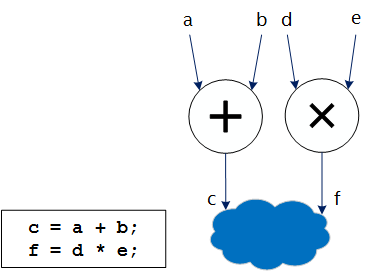Developer Guide
FPGA Optimization Guide for Intel® oneAPI Toolkits
A newer version of this document is available. Customers should click here to go to the newest version.
Executing Independent Operations Simultaneously
As described in Mapping Source Code Instructions to Hardware, the compiler can automatically identify independent operations and execute them simultaneously in hardware. This, when combined with pipelining (explained below), is how performance through data parallelism is achieved on the FPGA.
The following image illustrates an example of an adder and a multiplier, which are scheduled to execute simultaneously while operating on separate inputs:

This automatic vectorization is analogous to how a superscalar processor takes advantage of instruction-level parallelism, but this vectorization happens statically at compile time instead of dynamically, at runtime. This means that there is no hardware or runtime cost of dependency checking for the generated hardware datapath. Additionally, the flexible logic and routing of an FPGA mean that only the available resources (ALMs, DSPs, and so on) of the FPGA bound the number of independent operations operating simultaneously.
Unrolling Loops
You can unroll loops in the design by using loop attributes. Loop unrolling decreases the number of iterations executed at the expense of increasing hardware resource consumption corresponding to executing multiple iterations of the loop simultaneously. Once unrolled, the hardware resources are scheduled as described in Scheduling.
Conditional Statements
The Intel® oneAPI DPC++/C++ Compiler attempts to eliminate conditional or branch statements as much as possible. Conditionally executed code becomes predicated in the hardware. Predication increases the possibilities for executing operations simultaneously and achieving better performance. Additionally, removing branches allows the compiler to apply other optimizations to the design.
In the following example, the function foo runs unconditionally. The code that cannot be run unconditionally, like the memory assignments, retains a condition.
